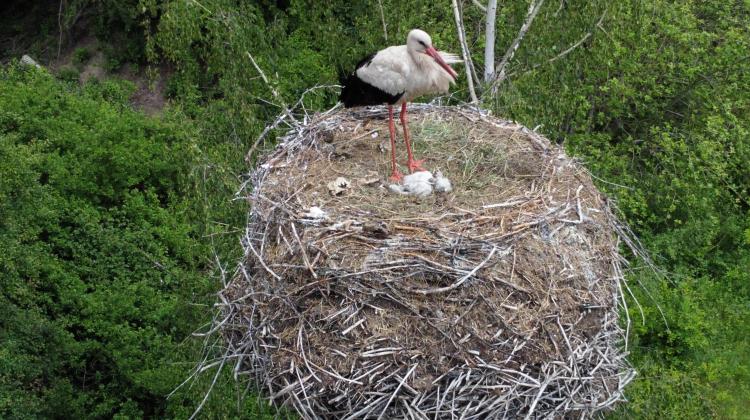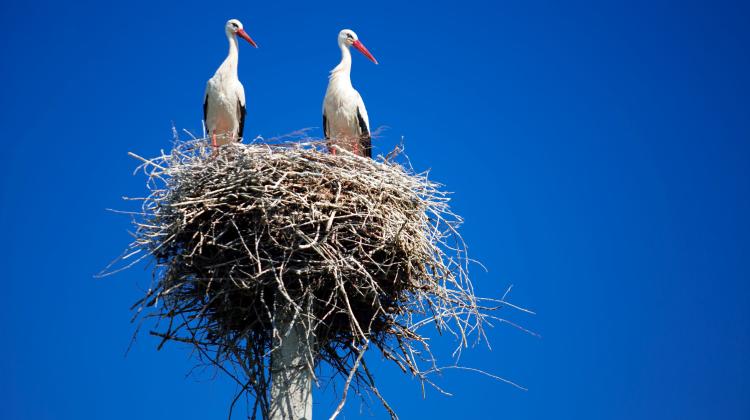It's confirmed: The largest stork nests in Europe weigh over a ton
 01.06.2022. PAP/Lech Muszyński
01.06.2022. PAP/Lech Muszyński
A competition to find Europe’s largest and heaviest stork nest has finished with the results revealing some weighing more than a ton.
Others exceeded 2-metres in both height and diameter.
Initiated by the University of Białystok as part of a science promotion project called 'You will not lift it! Promotion of the stork nest mass calculator’, researchers examined 27 nests in Poland, Spain, Croatia, Italy, the Netherlands and Belarus.
The top ten of largest nest were: Dubno in northern Podlasie (2 m high, 2.5 m wide), in Złaków Kościelny (2.3 m by 1.5 m), Urzecze (1.2 m by 1.8 m ) and Sobień Szlachecki (2 by 2 meters) in the Łódź province, Ujeździec Wielki (1.8 m by 1.5 m) in Lower Silesia, Nawiady (1.7 m by 1.5 m) and Zabrost Wielki (1.3 m by 1.6 m, mass of 964 kg) in the Warmian -Masurian province, in Węgielnia in the Suwałki region (1.7 m by 1.6 m), in Earnewâld in the Netherlands (2.2 m by 0.95 m) and in Belarus - in the villages Druya (1.5 m by 2.5 m), Malaja Berestovitsa (1.5 by 1.5 m) and in Orsha District (1.75 by 1.5 m).
The nests could reach such great sizes because most of them are located on unused objects such as ruins of buildings, old pressure towers, free-standing poles.
Consequently, they can grow without interference from members of the public.
Adam Zbyr, ornithologist and biologist, co-author of the book ‘Stork. An Unauthorized Biography ‘ said that the nests were measured from the ground using a laser, the data from which was entered into a special online calculator (www.gniazdo.ptop.org.pl).
The device was developed by scientists from the Faculty of Biology of the University of Białystok, the Institute of Dendrology of the Polish Academy of Sciences and the University of Wrocław.
The average weight of a stork nest in Poland is almost 400 kilograms.
The data come from weighing 145 nests, which Zbyryt dealt with during protective activities - moving 'threatened and conflict nests', located on the roofs of buildings or poles.
Nests are moved for two reasons: when the structures on which they are built are threatened with collapse - or when the birds have settled too close to houses, whose owners do not tolerate dirt, for example.
Zbyryt said: “The nests were weighed while they were being moved. It was the first time we obtained information on such a large scale concerning the nests weighed in full.”
He added that a 'new' nest, in the first year of existence, can weigh up to 70 kilograms. He said: “It shows how great energy expenditure their construction, attempting to create a nest from scratch, is for storks. It also helps to understand why storks often fight for existing nests.”
But the nest construction process never ends. Every year, storks returning from wintering grounds start expanding and repairing the nest. They add sticks, bring hay, straw, manure. Over time, the nest's interior decomposes and soil is formed. That is why the mass of the nest is so large.
Zgyryt added: “On the other hand, the decomposition process in the nests means that they do not grow indefinitely, but are decomposed and reduced. Still, when this process is slower, nests can reach 2-3 meters in height, at a diameter exceeding 2 meters. Such dimensions happen quite often. When looking from below, it is difficult to guess how big they are.”
PAP - Science in Poland
zan/ agt/ kap/
tr. RL
Przed dodaniem komentarza prosimy o zapoznanie z Regulaminem forum serwisu Nauka w Polsce.


















